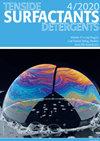Adsorption of Ni2+ by functionalized hydroxyapatite-chitosan composite
IF 1.2
4区 工程技术
Q4 CHEMISTRY, APPLIED
引用次数: 1
Abstract
Abstract Chitosan and hydroxyapatite are commonly used materials for adsorption. In this work, chitosan was modified by polyethylene glycol and maleic anhydride. Subsequently, a hydroxyapatite-chitosan composite was synthesised by precipitation. The composite was characterised and analysed by Fourier transform infrared spectroscopy (FTIR), scanning electron microscopy (SEM), thermogravimetric analysis (TGA) and X-ray photoelectron spectroscopy (XPS). Adsorption experiments were used to investigate the effects of external factors such as different pH values, adsorbent dosage, adsorption time and initial nickel ion concentration on the adsorption capacity of Ni2+ and to discuss the mechanism of Ni2+ removal by composites. The results show that the hydroxyapatite-chitosan composite has significant adsorption of Ni2+. The adsorption capacity of the hydroxyapatite-chitosan composite for Ni2+ reaches 63.8 mg g−1. The adsorption process is consistent with the pseudo-second-order kinetic model and the Langmuir isothermal model.功能化羟基磷灰石-壳聚糖复合材料对Ni2+的吸附
摘要壳聚糖和羟基磷灰石是常用的吸附材料。以聚乙二醇和马来酸酐为原料对壳聚糖进行改性。随后,通过沉淀法合成了羟基磷灰石-壳聚糖复合材料。通过傅立叶变换红外光谱(FTIR)、扫描电子显微镜(SEM)、热重分析(TGA)和X射线光电子能谱(XPS)对复合材料进行了表征和分析。采用吸附实验研究了不同pH值、吸附剂用量、吸附时间和初始镍离子浓度等外部因素对Ni2+吸附容量的影响,并探讨了复合材料去除Ni2+的机理。结果表明,羟基磷灰石-壳聚糖复合材料对Ni2+有明显的吸附作用。羟基磷灰石-壳聚糖复合材料对Ni2+的吸附容量达到63.8 毫克 g−1。吸附过程符合拟二阶动力学模型和Langmuir等温模型。
本文章由计算机程序翻译,如有差异,请以英文原文为准。
求助全文
约1分钟内获得全文
求助全文
来源期刊

Tenside Surfactants Detergents
工程技术-工程:化工
CiteScore
1.90
自引率
10.00%
发文量
57
审稿时长
3.8 months
期刊介绍:
Tenside Surfactants Detergents offers the most recent results of research and development in all fields of surfactant chemistry, such as: synthesis, analysis, physicochemical properties, new types of surfactants, progress in production processes, application-related problems and environmental behavior. Since 1964 Tenside Surfactants Detergents offers strictly peer-reviewed, high-quality articles by renowned specialists around the world.
 求助内容:
求助内容: 应助结果提醒方式:
应助结果提醒方式:


